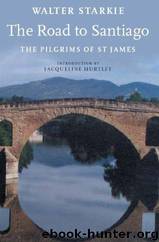The Road to Santiago: Pilgrims of St. James by Walter Starkie

Author:Walter Starkie [Starkie, Walter]
Language: eng
Format: epub
Publisher: John Murray Publishers Ltd
Published: 2013-07-26T16:00:00+00:00
ESTELLA TO LOGROÑO AND NÁJERA
My friends saw me off at the bridge, but Don Maríano tramped with me along the first stage of my journey. We followed the banks of the River Arga, avoiding the main road and keeping to the track which marks the original Road of St. James. On that sunny spring morning it was invigorating to step out at a good pace through the undulating valley; the birds were singing, butterflies were flitting in the sunlight and there was the buzzing of myriads of bees. We exchanged greetings with the shepherd, whom I had met on the bridge the day before, and later passed a goatherd who was lying under an oak tree surrounded by his flock. We soon came to a rustic fountain where, according to Maríano, the pilgrims used to wash themselves in the early morning before continuing their journey. After a stiff climb we reached the ancient houses of MaSeru, which belonged for three centuries to the Order of St. John of Jerusalem. Don Maríano then turned left off the main road on to a bypath which was the Jacobean road to the beautiful Romanesque church of Cirauqui perched on a hill. I said farewell to my wise mentor Don Maríano la Tienda and proceeded on my way alone.
Soon I reached the River Salado and crossed by a picturesque bridge with two uneven arches. Here, Aymery Picaud warns pilgrims not to drink the water or allow their horses near it (quia flumen letiferum est). He describes how when he reached the bridge he saw two Navarrese sharpening their knives in readiness for skinning the pilgrim mules or horses who would drop dead when they had drunk the water. And when Aymery asked them whether the water was fit to drink they replied in the affirmative. ‘And so’, he continues, ‘we watered our horses, and two of them straightway died, and the two men skinned them.’ I tasted the brackish water without any sinister results.
This is a very lonely spot and gave me such an attack of the blues that I was glad to hasten away and mount the hill towards the village of Lorca, where, according to Lacarra, there was in 1209 a hospital dependent on the Monastery of Our Lady of Roncesvalles. At Lorca I rested in a tavern, where I met a Good Samaritan: he gave me a seat beside him on his van and we soon reached the city of Estella.
According to Aymery Picaud the third stage of the Jacobean journey by road ends at Estella. These stages vary in distance, but most of them are calculated for horsemen, for the fourth stage from Estella to Nájera is seventy-six and the fifth from Nájera to Burgos is ninety kilometres, both far beyond the day’s tramp of the most ambitious foot-slogger.
Estella was universally popular among the mediaeval pilgrims, because there they found excellent bread, wine, fish and meat. According to Aymery, it was full of every blessing. The thirteenth-century writer, Peter the
Download
This site does not store any files on its server. We only index and link to content provided by other sites. Please contact the content providers to delete copyright contents if any and email us, we'll remove relevant links or contents immediately.
Spell It Out by David Crystal(35365)
Underground: A Human History of the Worlds Beneath Our Feet by Will Hunt(11279)
A Year in the Merde by Stephen Clarke(4670)
Venice by Jan Morris(2058)
Claridge's: The Cookbook by Nail Martyn & Erickson Meredith(1974)
My Paris Kitchen: Recipes and Stories by Lebovitz David(1897)
A TIME OF GIFTS by Patrick Leigh Fermor(1853)
The Plantagenets by Dan Jones(1623)
Welcome to the Goddamn Ice Cube by Blair Braverman(1609)
Bang Poland: How To Make Love With Polish Girls In Poland by Roosh V(1595)
Top 10 Prague (EYEWITNESS TOP 10 TRAVEL GUIDES) by DK(1572)
From Russia with Lunch by David Smiedt(1555)
The Finnish Way by Katja Pantzar(1540)
The Isle of Mull by Terry Marsh(1523)
A TIME TO KEEP SILENCE by Patrick Leigh Fermor(1504)
Rick Steves London 2018 by Rick Steves & Gene Openshaw(1498)
A Taste of Paris by David Downie(1496)
Merde in Europe by Stephen Clarke(1439)
Insight Guides Experience Tokyo by Insight Guides(1422)
